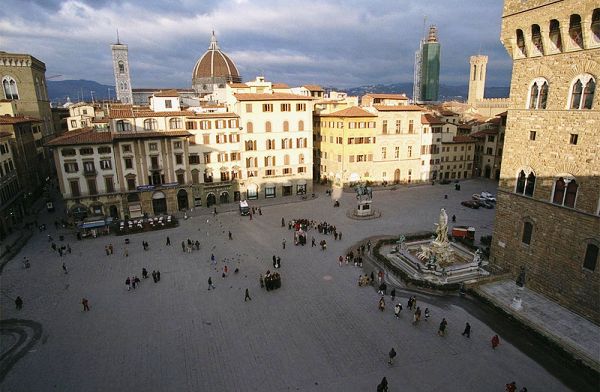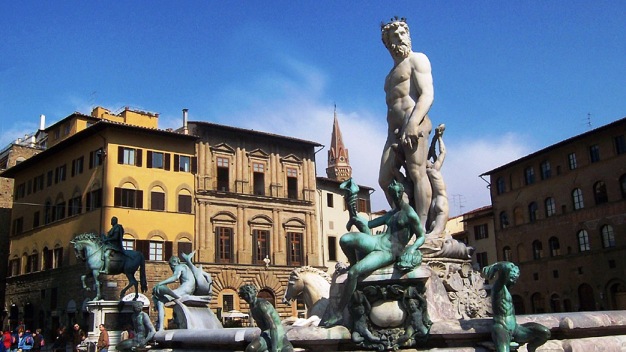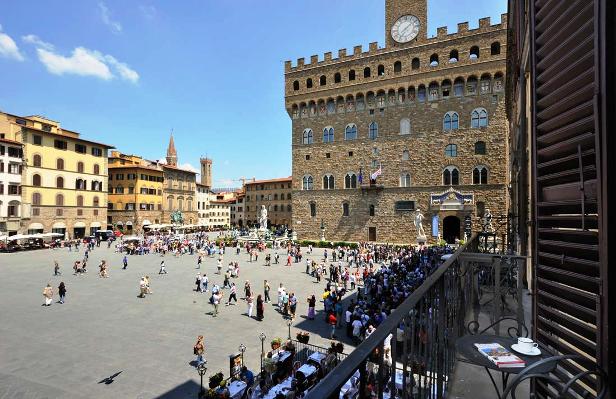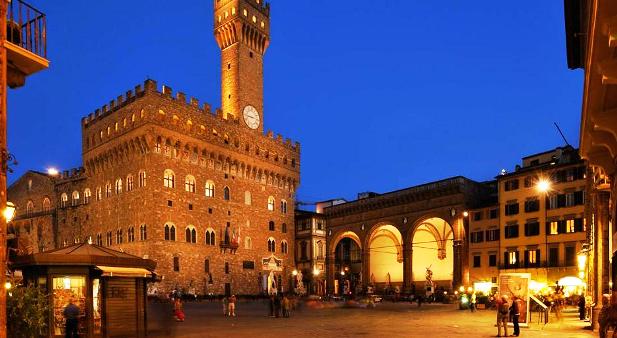The Piazza della Signoria in Florence Italy has been the center of political life in Florence since the 14th century. It was the scene of great triumphs, such as the return of the Medici in 1530 as well as the Bonfire of the Vanities instigated by Savonarola, who was then himself burned at the stake here in 1498 after he was denounced by the Inquisition as a heretic. A marble circle inscription on the piazza shows the location where he was burned.

The sculptures in Piazza della Signoria bristle with political connotations, many of which are fiercely contradictory. The David (the original is in the Galleria dell’Accademia) by Michelangelo was placed outside the Palazzo Vecchio as a symbol of the Republic’s defiance of the tyrannical Medici.
Andinelli’s Hercules and Cacus (1534) to the right of the David was appropriated by the Medici to show their physical power after their return from exile. The Nettuno (1575) by Ammannati celebrates the Medici’s maritime ambitions and Giambologna’s equestrian statue of Duke Cosimo I (1595) is an elegant portrait of the man who brought all of Tuscany under Medici military rule.
The graceful Loggia dei Lanzi, which functions as an open-air sculpture gallery, was designed by Orcagna in 1376. Its curved arches foretell Renaissance classicism. The statue of Perseo holding Medusa’s head, by Cellini (1554), is a stark reminder of what happened to those who crossed the Medici, and along with Giambologna’s Rape of the Sabines, are two of many beautiful sculptures found under the arches of the Loggia dei Lanzi.

From the Piazza della Signoria you can go through the Vasari corridor, which runs through the Uffizi, and over the Ponte Vecchio bridge to the Pitti Palace on the other side of the River Arno. The Vasari corridor was constructed by Vasari after the Medici family moved into the Pitti Palace, to provide a covered passage back to the town square. Today, you can walk past all of the shops from the Piazza della Signoria all the way to the Pitti Palace.

The Piazza della Signoria is full of magnificent statues and fountains. There are several restaurants and bars, so many of the locals and tourists fill the L-shaped square, day and night. It is a great place to start a walking tour of Florence that would include the town center, Palazzo Vecchio, The Uffizi,Vasari Corridor, Vecchio Bridge and the Pitti Palace which include the Boboli Gardens. In fact you can buy tickets that include three of the points of interest on a pass.

Florence Italy has more art and culture than any place I can think of. You can feel the humbling power of walking past the statues by Michelangelo and Donatello, shopping in local shops, crossing the river shopping district, or the view from the Boboli Gardens. From Piazza della Signoria, you are centrally located to take in these famous landmarks, eat in some of Florence’s finest restaurants or drink Tuscan wine for a memorable visit. There are lots of photo opportunities, so don’t forget your camera!
